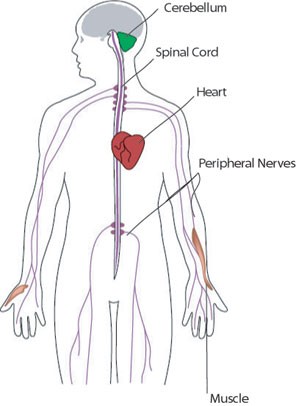Friedreich’s Ataxia (FRDA) is an autosomal recessive neurodegenerative disorder with an occurrence frequency of approximately 1 out of 50.000 people and a carrier frequency of ~1/90. Friedreich’s ataxia is mainly characterized by acute and progressive limb ataxia, walking difficulties, loss of deep tendon reflex and loss of position sense. Manifestation of symptoms usually begins in puberty and is completed by the age of 25, with a slow yet progressive expression of the disease. In >98% of the cases the disorder is caused by a pathological expansion of GAA triplet repeats on both copies of the fraxatin gene at chromosome 9q13.
Friedreich’s ataxia

NOTE: Our laboratory participates with great success in the external quality assessment scheme organized by the European Molecular Genetics Quality Network (EMQN), which is periodically applied for Friedreich’s Ataxia (FRDA).
We apply a specially designed multiplex polymerase chain reaction (PCR) and a triplet-repeat PCR (TR-PCR), for the detection of the precise number of GAA triplet repeats as well as the detection of large triplet expansions at the frataxin gene.
For all prenatal molecular genetic testing, we perform analysis of polymorphic STR markers from a maternal blood sample and the fetal sample, in order to exclude any possible maternal cell contamination. Thus, for prenatal diagnosis, 1-2ml of a maternal blood sample should always accompany the fetal sample (amniotic fluid or CVS).